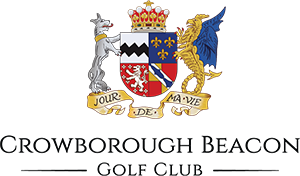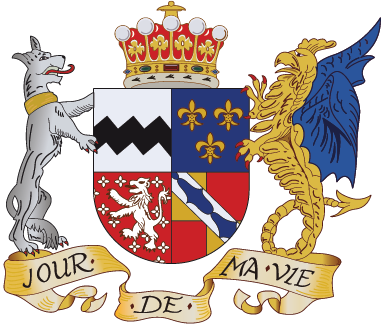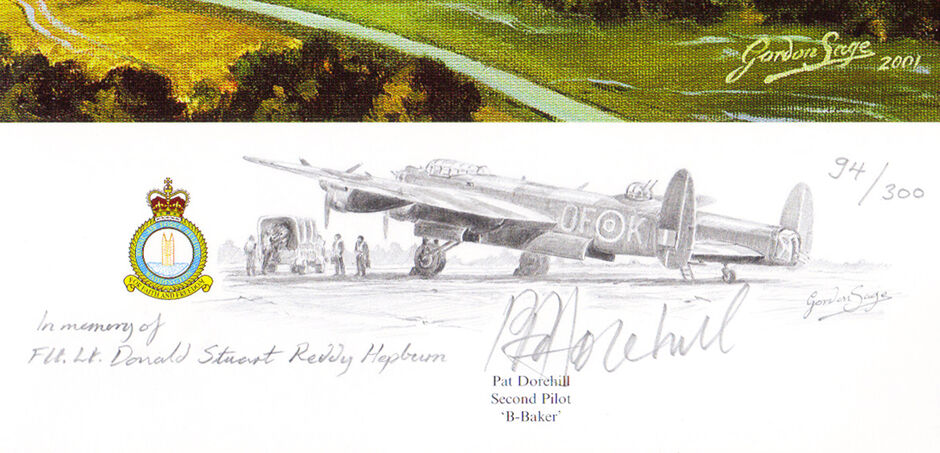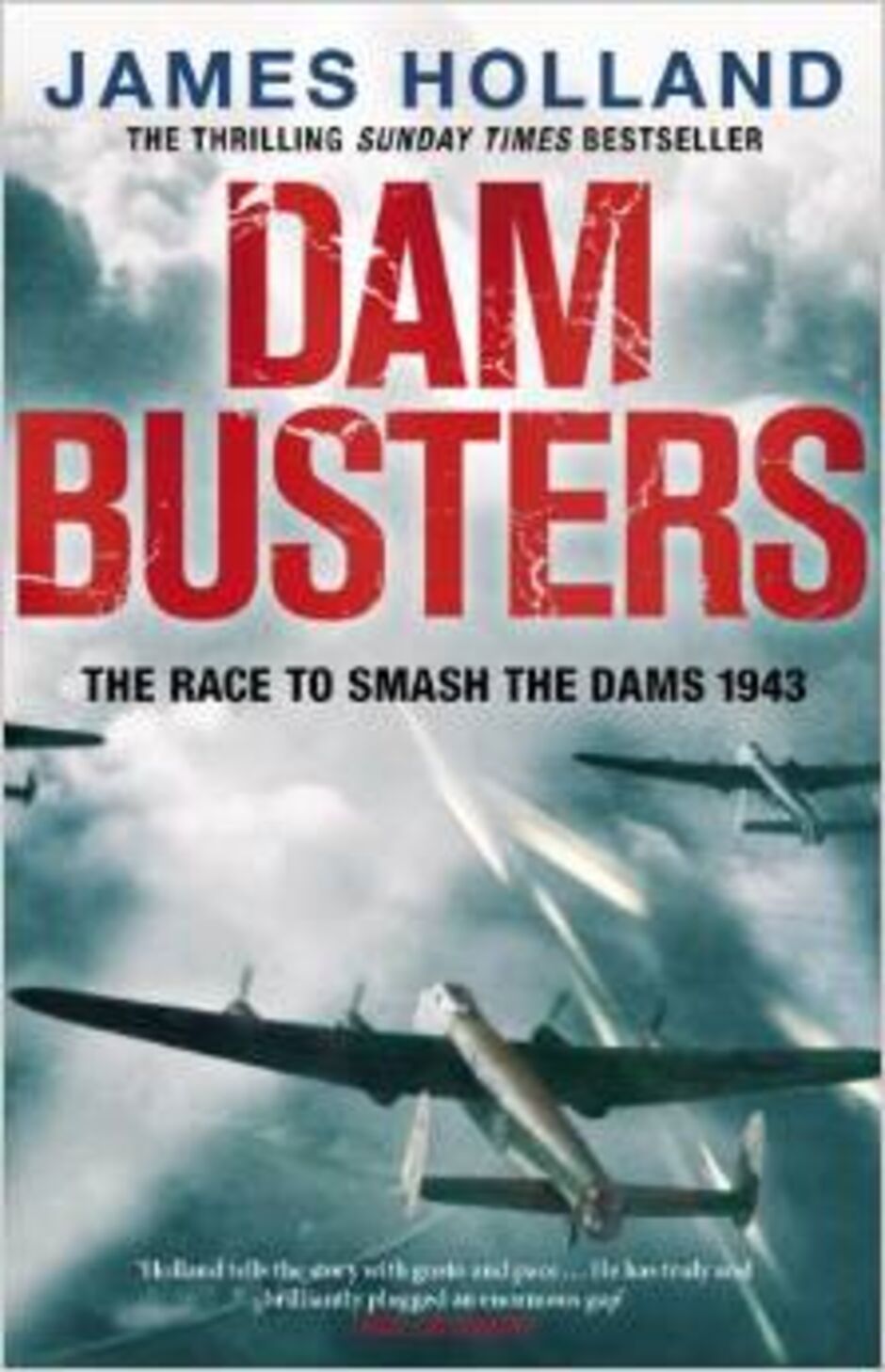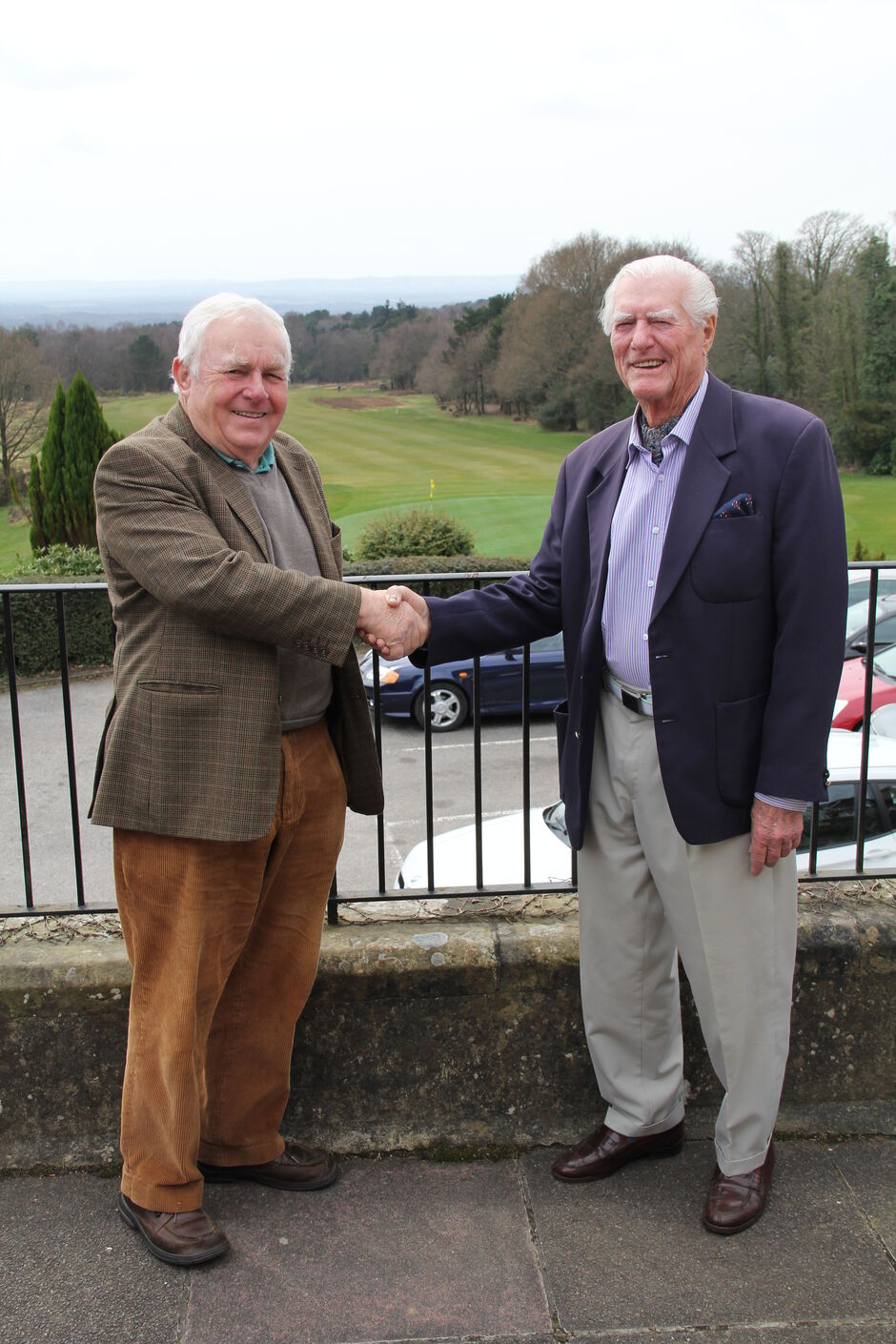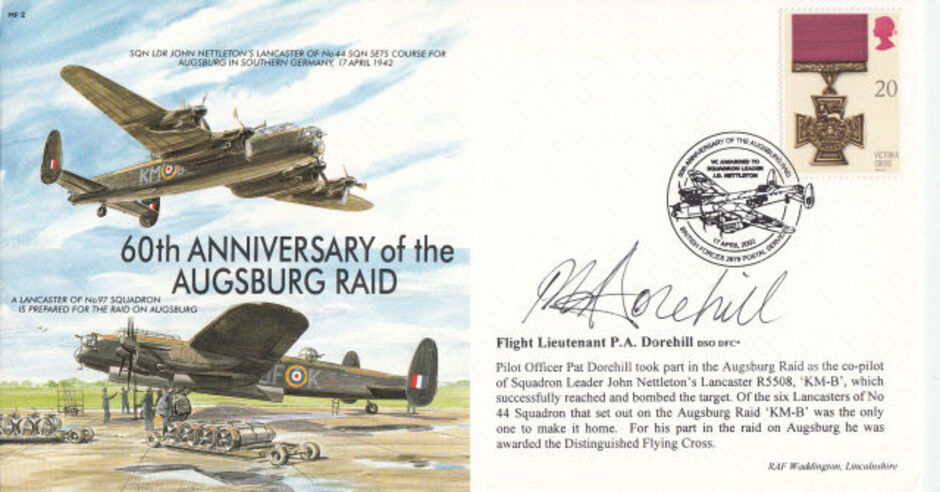Patrick Dorehill - Honorary Member
Crowborough Beacon Golf Club
The below publication and BBC interview were released on 17th April 2012, on the 70th Anniversary of the famous Augsburg Raid of WW2, at which point Patrick was the remaining survivor of this historic event.
Sadly Patrick passed away on Monday 6th June 2016, aged 94.
In memory of Patrick, as Club Chairman John Burke stated at the January 2015 AGM, we commend you to read on below for the story of the Augsburg Raid.
At the 120th AGM of Crowborough Beacon Golf Club held in the Clubhouse on Saturday 10th January 2015, item 10 on the Agenda was for the awarding of Honorary Membership to long-standing member of the golf club, Patrick Dorehill. Chairman John Burke briefly introduced to the 93 members present, Patrick, a member of the Golf Club for over 20 years.
Whilst a fall off the 5th green fracturing a shoulder aged 89 was not a career highlight, his hole-in-one on the 13th hole on 22nd April 2013, aged 91, certainly was. John also made mention of Patrick's distinguished war record, during which, co-pilot in a Lancaster bomber, he took part in one of World War 2's most famous missions and he commended all members to read about this historic event.
Patrick now 93, whilst accepting the award, gave a moving acceptance speech. Patrick was Squadron Leader John Nettleton's co-pilot on the Augsburg Raid in Lancaster 'KM-B' for Baker of No 44 Squadron and he was awarded the Distinguished Flying Cross (DFC) for his part in the raid. Nettleton received the VC.
Below you will find the story of the Augsburg Raid as published by the RAF in recognition of the 70th Anniversary in 2012 at RAF Waddington at which Patrick was present, along with the grandson of Squadron Leader John Nettleton.
The Story of The Augsburg Raid
17th April 1942
On Christmas Eve 1941, RAF Waddington's 44 Squadron received a Christmas present: the first of the new Avro Lancasters, which would replace its aging and inadequate Handley Page Hampdens. Although the Lancaster was not perfect - early aircraft suffered from cracks in the wing skins, wingtip failures and unreliable turrets - the new aircraft was welcomed by air and ground crews alike. It was obvious that the new machine was a vast improvement and this improvement led to a bold plan, outlined in Bomber Command Operation Order No 143, now held in the National Archives at Kew.
The Order concluded that the new Lancaster should be able to cross the coast of France in daylight at a weak point, penetrate deep inland without meeting serious opposition and attack with comparative precision vital targets which had not so far been attacked due to the difficulty of finding them at night or because of their distance. Such an attack "should cause considerable alarm and despondency among the population who at present may consider themselves outside the danger area".

(Colour plate of Nettletons aircraft KM-B, R5508)
The target selected for the experiment - Operation MARGIN - was the MAN Diesel Factory at Augsburg, deep in Bavaria, a major producer of diesel engines for German U-boats. Two squadrons were detailed, Waddington's 44 Squadron and 97 Squadron at Woodhall Spa, each providing six aircraft plus one reserve.
The 44 Squadron formation would be led by 25 year old Squadron Leader John Nettleton from South Africa, a first tourist pilot who had carried out fifteen operational sorties. A former merchant seaman who had joined the RAF in 1938, Nettleton was well aware of the appalling losses being suffered in the Battle of the Atlantic. 97 Squadron would be led by 23 year old Squadron Leader John Sherwood, who was commissioned into the RAF in 1937. He had been awarded the DFC during his first tour and also held a bar after a daylight raid on the Scharnhorst and Gneisenau at Brest.
During the week of 12 -16 April, both squadrons were taken off ops to practise low level formation flying and bombing on the range at Wainfleet. The final practice flight took the bombers south to Selsey Bill, north to a practice target in Inverness and then back to base. Before the raid, only the formation leaders had been let into the secret about the target, but whatever they were practising for, the crews knew it would mean a long flight at low level.
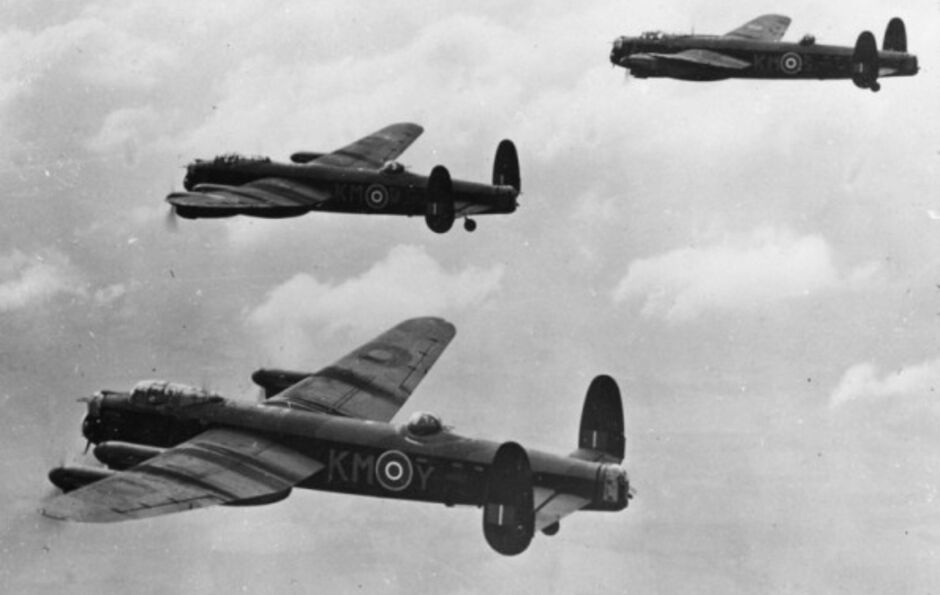
44 Squadron Lancasters practicing low-level flying for the Augsburg raid
The crews learnt their target at simultaneous briefings at 1100 hrs on Friday 17 April. Waddington crews greeted the news with a quiet gasp. At Woodhall Spa, some men burst out laughing when the curtain was pulled back to reveal the route and target. It was some seconds before they realised that it wasn't a joke, they really were expected to fly deep into Bavaria in daylight!
In 44's formation, Nettleton led the first vic of three, whilst the second vic was led by Flight Lieutenant Nick Sandford, who always wore pyjamas under his flying gear. The wingmen for both vic leaders held a cluster of DFMs. Unfortunately, space does not allow each man who took part in the raid to be named but each aircraft carried a crew of seven, who had vital roles to play and who all took the same risks.
Sherwood led the first vic for 97 Squadron. On his right wing was Eric Rodley. Before going out to the aircraft, he had seen other crewmen getting hold of extra armour plate to protect the parts of their body that they considered most vital! Improvising, Rodley quickly grabbed his steel helmet and placed it on the pilot's seat before settling down. He spent the entire flight rocking gently on his upturned tin helmet.
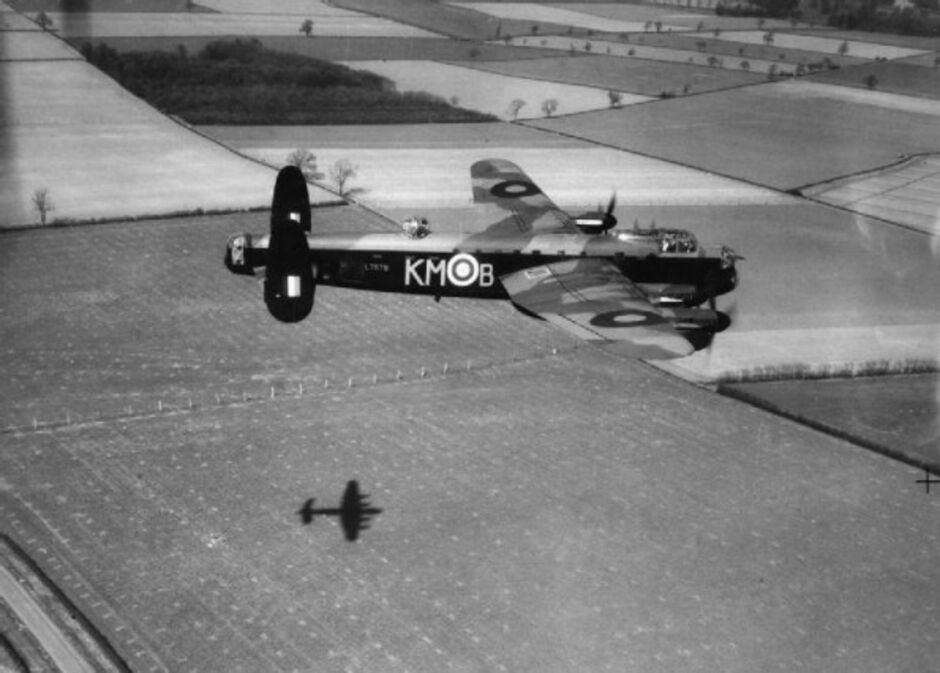
Lancaster of Sqd.Ldr.Nettleton leading the last low-level formation flight before the raid
F/L David Penman led the second vic of three. On his right was 22 year old WO Tom Mycock, who had already won a DFC over Brest. FO Ernest Alfred Deverill, a Halton Brat (ex-apprentice) was on the left wing. He had flown over a hundred operational sorties, mostly in Coastal Command, and had won the DFM for bringing back a damaged Hudson with a dead gunner and a wounded second pilot, after an attack by three Me 109s.
EN ROUTE
Both Squadrons proceeded independently to the rendezvous point at Selsey Bill on the afternoon of 17 April. From there the two formations crossed the English Channel and flew into France east of Caen at 1645 hrs. Nettleton led his crews down to twenty to thirty feet, so low that they had to ease the aircraft up to clear trees in their path.
In Sherwood's aircraft, it was thought that Nettleton was taking them north of track. The two formations planned to separate near the target and attack independently but Sherwood decided to follow his navigator's advice now and the two formations began to separate, eventually losing sight of each other
44 Squadron's flight path took them close to the Luftwaffe airfield at Beaumont-le-Roger. Warrant Officer Hubert Crum's Lancaster flew along the perimeter track as three German fighters were landing. The Lancaster crews hoped they had not been seen, but when the 109s stopped their descent, retracted their wheels, and climbed away from the airfield, it was obvious they had been spotted.
In the rear vic, Warrant Officer Joe Beckett's crew was the first to die. Hit by a hail of cannon shells, the aircraft became a mass of flames, dived into a clump of trees and disintegrated. Then Crum's fuselage was ripped apart by cannon fire. With two gunners wounded and his port wing in flames, Crum jettisoned his bombs and crash landed straight ahead. Nick Sandford flew under high tension wires trying to dodge an attack by three fighters. He was unsuccessful and, with all four engines on fire, his Lancaster crashed and exploded in a giant fireball with the loss of all the crew.
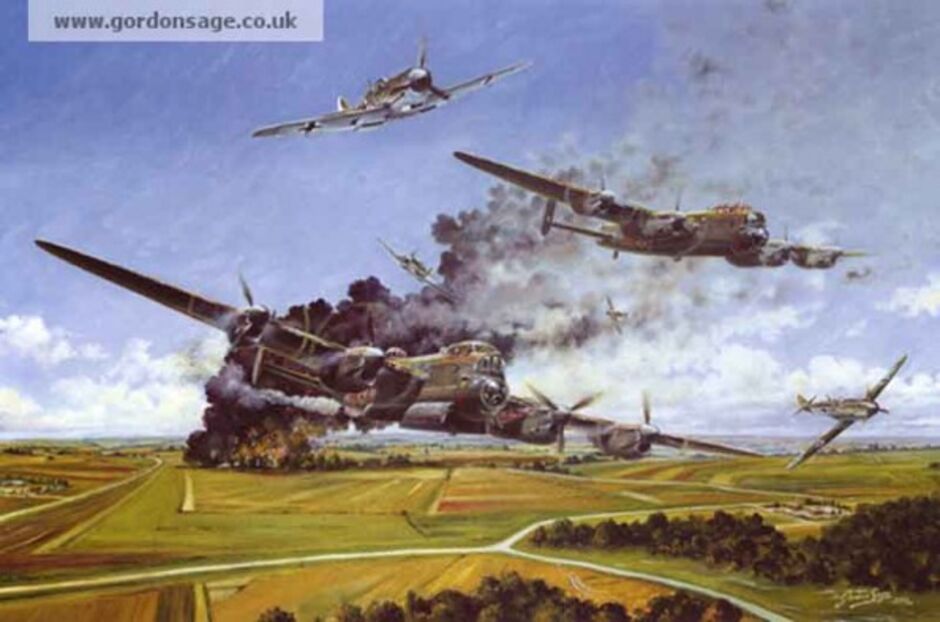
Augsburg Raid - Limited edition by artist Gordon Sage
The original hangs in the Sergeant's Mess at RAF Waddington
A copy of this limited edition, signed by Patrick Dorehill in 2015 now hangs in the
Crowborough Beacon Golf Club clubhouse lounge
With every gun on Sgt "˜Dusty' Rhodes' Lancaster jammed, they were unable to fight back when attacked by two 109s. Both port engines erupted in flames, the fire spreading instantly to the starboard motors. The Lancaster reared up, stalled and crashed vertically in flames with no survivors. Finally, FO "˜Ginger' Garwell's starboard wing was shredded by bullets during an attack, but the aircraft was able to continue.
Twenty-one men were dead and seven - all later captured - were on the run. Only Nettleton and Garwell flew on across France. Further south, 97 Squadron continued unmolested. Once south of Paris, the formations turned for the final leg to Augsburg.
ON TARGET
Nettleton and Garwell were first to attack. They approached from south then made their bomb run from the east. The factory showed up clearly but they immediately met light flak and both Lancasters were hit repeatedly. Nettleton climbed to drop his bombs then started evasive action. Garwell followed but, after dropping his bombs, the Lancaster was hit. The fuselage aft of the cockpit was like an open furnace. Garwell crash-landed the Lancaster; he and three of his crew survived, but the other three crewmembers died.
Nettleton, alone, turned for home. 97 Squadron arrived just after 44's attack and received heavy flak. Sherwood's formation was the first to attack, but just after he had dropped his bombs, black smoke was seen pouring from one of the engines. One of Rodley's gunners saw Sherwood crash in a "flaming chrysanthemum".
Penman's formation was next. With three miles to run to the target, Tom Mycock's aircraft was hit in the front turret, probably killing the front gunner but definitely setting the aircraft on fire. Mycock and his crew could have done several things at this point. They could have climbed away to try to bail out or they could have jettisoned the bombs to make an immediate crash-landing. However, with the Lancaster's whole port wing on fire, they kept going. Mycock stayed on the bomb run until he knew his bombs had gone. Then his Lancaster reared up, passed over Penman's aircraft, and plunged into ground. There were no survivors.
When they were clear of the target, each aircraft climbed to a higher level and returned to the UK in darkness. The remaining four aircraft of 97 Squadron landed at their home base between 1057 and 1115 hrs. Nettleton and his crew, unsure of their position, landed at Squire's Gate (Blackpool) at 0055 hrs. Of the six Lancasters that had set out from Waddington, not one returned that day.
AFTERWARDS
Back in England, congratulations came from the Prime Minister, Winston Churchill:
"We must plainly regard the attack of the Lancasters on the U-boat engine factory at Augsburg as an outstanding achievement of the Royal Air Force. Undeterred by heavy losses at the outset, 44 and 97 Squadrons pierced and struck a vital point with deadly precision in broad daylight. Pray convey the thanks of His Majesty's Government to the officers and men who accomplished this memorial feat of arms in which no life was lost in vain."
Nettleton received the VC and Penman the DSO. Eight DFCs were awarded and ten DFMs. When it was known that they were safe, a DFC went to Garwell and DFMs to three further crew members. Sherwood was recommended for the VC and the recommendation was supported all the way to the top. His citation survives, but scrawled across the top by some unnamed hand is the sentence "To be recommended for DSO if later found to be alive." Miraculously, Sherwood was alive, thrown clear from the crash still strapped into his seat. The rest of his crew were killed.
But what about Tom Mycock? In any other operation, Mycock might have been awarded a Victoria Cross. But Nettleton had already received the award, Sherwood's recommendation had been disallowed and no other posthumous award existed in 1942. Mycock's gallantry went unrewarded.
Whilst the physical results of the raid were not great, it was a huge propaganda success and Nettleton and others appeared in the newspapers and in newsreels. But the raid was not repeated. The loss of seven out of twelve Lancasters and crews made such attacks unsustainable. Of the eighty-five men who set out from Waddington and Woodhall Spa, thirty-seven were dead and twelve prisoners.
Message from Chief of the Air Staff:
"I would like 44 and 97 Squadrons to know the great importance I attach to this gallant and successful attack on the diesel engine factory at Augsburg. Please give my warmest congratulations and thanks."
From Air Marshall A.T. Harris:
"Convey to the crews of 44 and 97 Squadrons who took part in the Augsburg raid, the following: the resounding blow which has been struck at the enemy's submarine and tank building programme will echo round the world. The full effects of his submarine campaigns cannot be immediately apparent, but nevertheless they will be enormous. The gallant adventure penetrating deep into the heart of Germany in daylight and pressed home with outstanding determination in the face of bitter and unforeseen opposition takes its place amongst the most courageous operations of the war. It is moreover yet another fine example of effective cooperation with the other services by striking at the very sources of the enemy effort. The officers and men who took part, those who returned and those who fell, have indeed served their country well"
The last word lay with Admiral Sir Dudley Pound, the Chief of Naval Staff
who waited for some days before he made this signal to the Bomber Chief:
"I have now seen the photographs and assessment. I am sure this attack will have greatly helped in achieving our objective. I much deplore the comparatively heavy casualties but I feel sure their loss was not in vain."
The crew of Nettleton's aircraft KM-B, R5508 44 Squadron 'B-Baker'
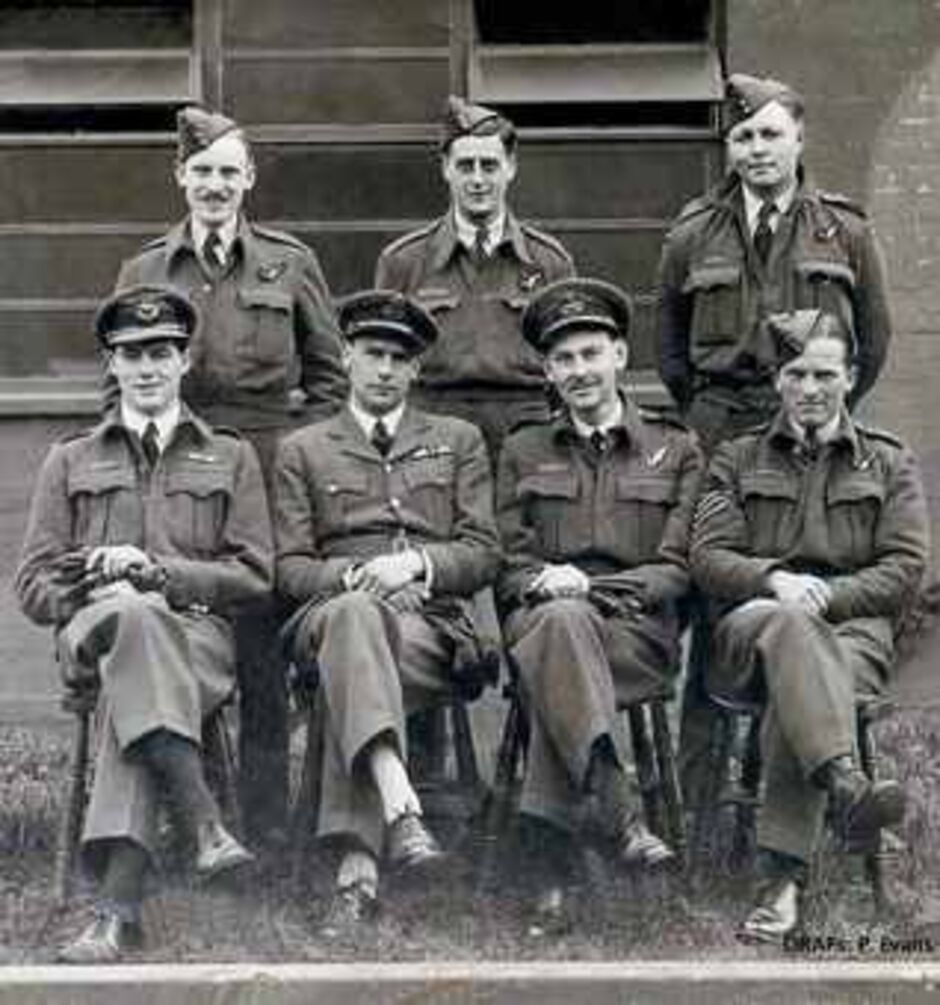
Back Row L - R: F/Sgt Leonard Henry Mutter DFM (Cardiff),
F/Sgt Frank Howe Harrison DFM (Cardiff), Sgt Donald Norman [buzzer] Huntley (Rhodesia).
Front Row L - R: Plt Off Patrick Arthur Dorehill DFM (Rhodesia),
Sqn Ldr John Deering Nettleton VC (South Africa & Rhodesia), Plt Off D.O. Sands DFC (London),
Flt Sgt Charles Flemming Churchill DFM (South Africa.)
Other Useful Links
Whilst researching online archives for the purpose of this webpage, an enormous variety of fascinating information was uncovered. At the foot of the page you will find links that you can click through to be directed to view TV programmes which are available on YouTube which provide compelling viewing.
Two books of great interest are worthy of mention. Firstly the Augsburg Raid by Jack Currie published in 1987 now out of print. Secondly, a new book on the Dambusters published in 2012 by James Holland.
The Prologue of James Holland's excellent book includes a gripping account of The Augsburg Raid and Patrick Dorehill's part in this. After contacting James Holland in person, I am delighted that he gave his permission to publish the Prologue in full, unedited, to accompany and complement what lies above. You can read it by clicking on this link
Dam Busters Prologue.pdf
Thank you James for allowing us to use your work. Click on the picture below to visit a dedicated James Holland page featuring more information on his book "Dam Busters - The Race to Smash the Dams 1943" and a 60 minute television programme.
This link is to an excellent TV documentary on the Augsburg Raid recorded in March 1989.
watch it here
This link is to another vintage TV documentary entitled 'The Lancaster Legend', made in 1980 to accompany the late Squadron Leader Jack Currie's book 'Lancaster Target'. This is not about Augsburg but nevertheless makes a compelling companion to the first documentary and well worth viewing.
watch it here
This final video link is a short opportunity to experience the thrill of flight alongside a Lancaster Bomber which is beautifully filmed.
watch it here

Vice-President Richard Pace (on the left) congratulating Patrick Dorehill on his 'ace' on the 13th hole at Crowborough Beacon Golf Club on 22nd April 2013
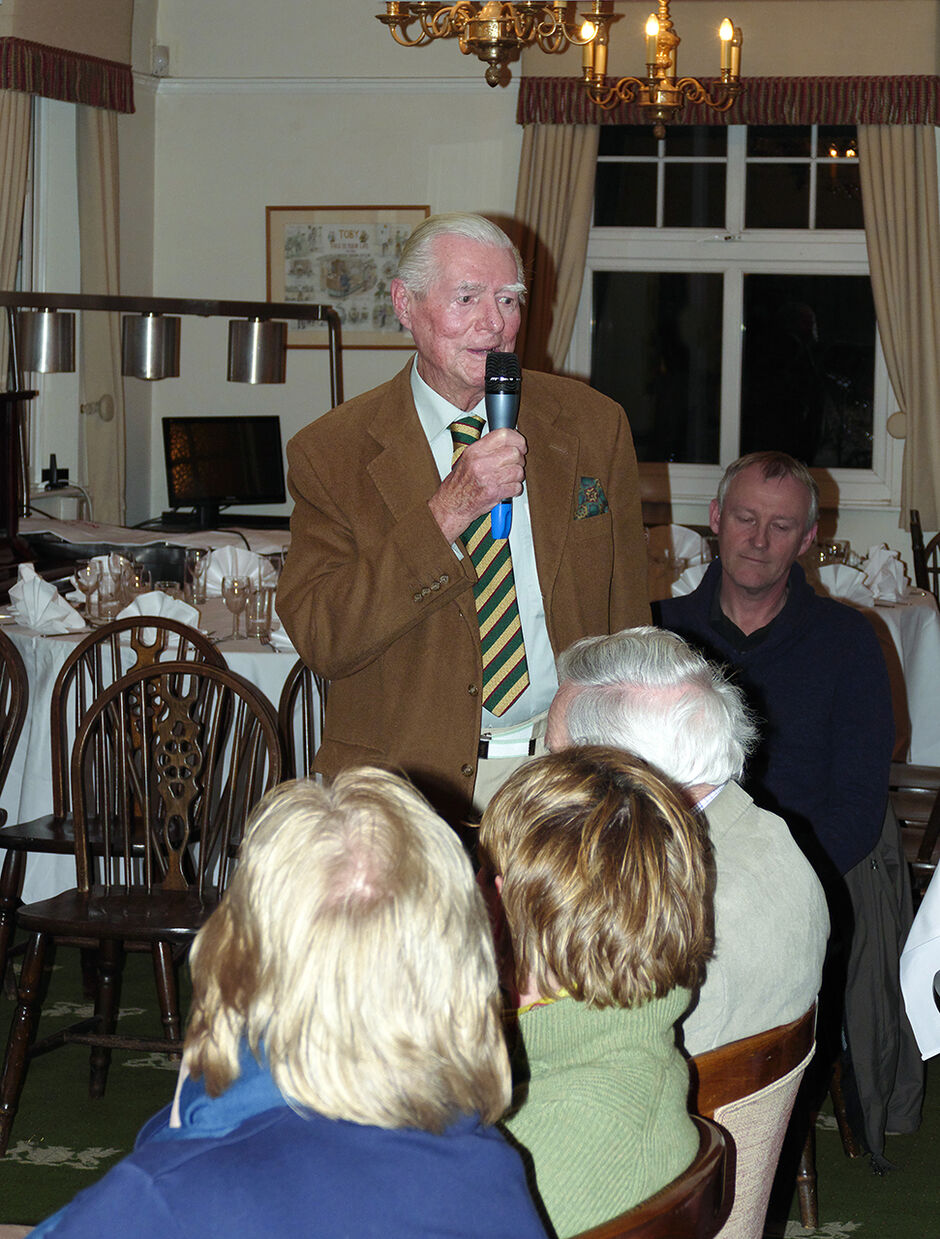
Patrick Dorehill making his acceptance speech in the Clubhouse at the 10th January 2015 Annual General Meeting.
60th Anniversary Commemorative issue.
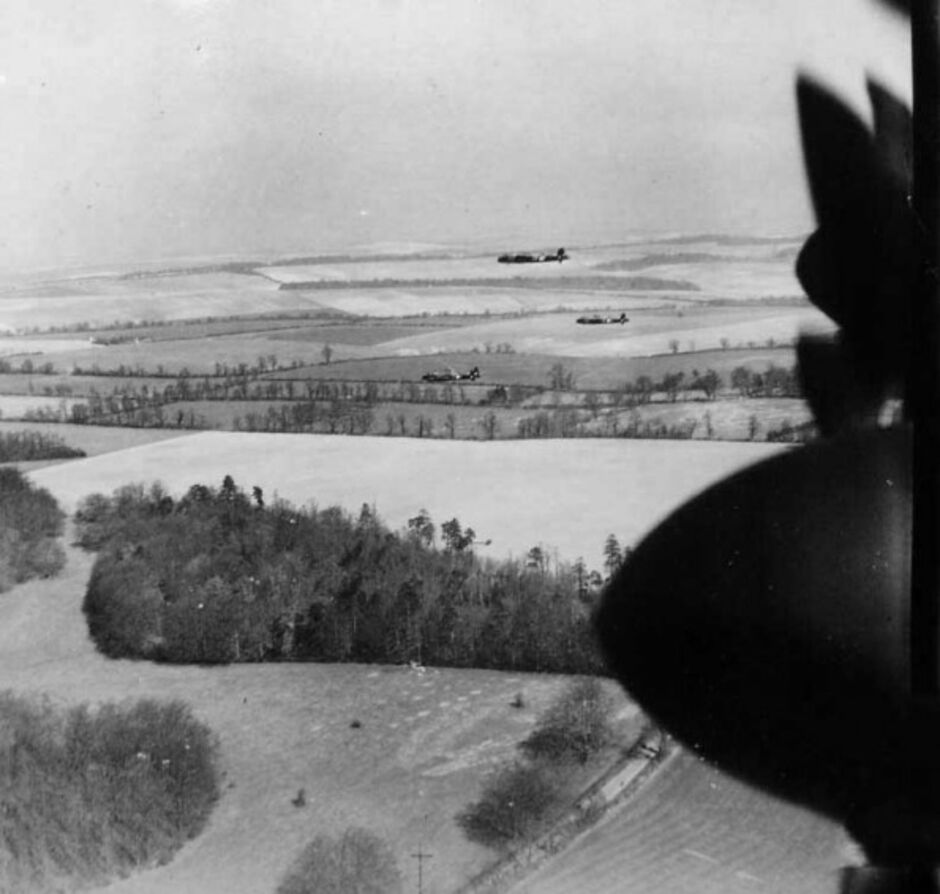
97 Squadron low-level practice for the Augsburg raid - thee Lancasters visible in the distance

